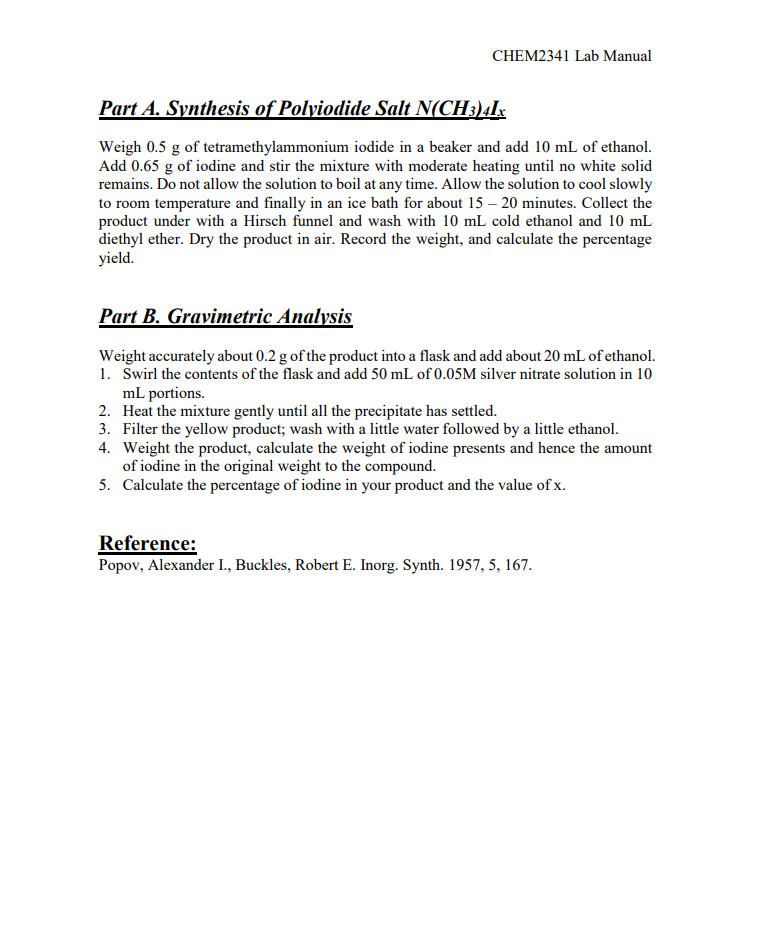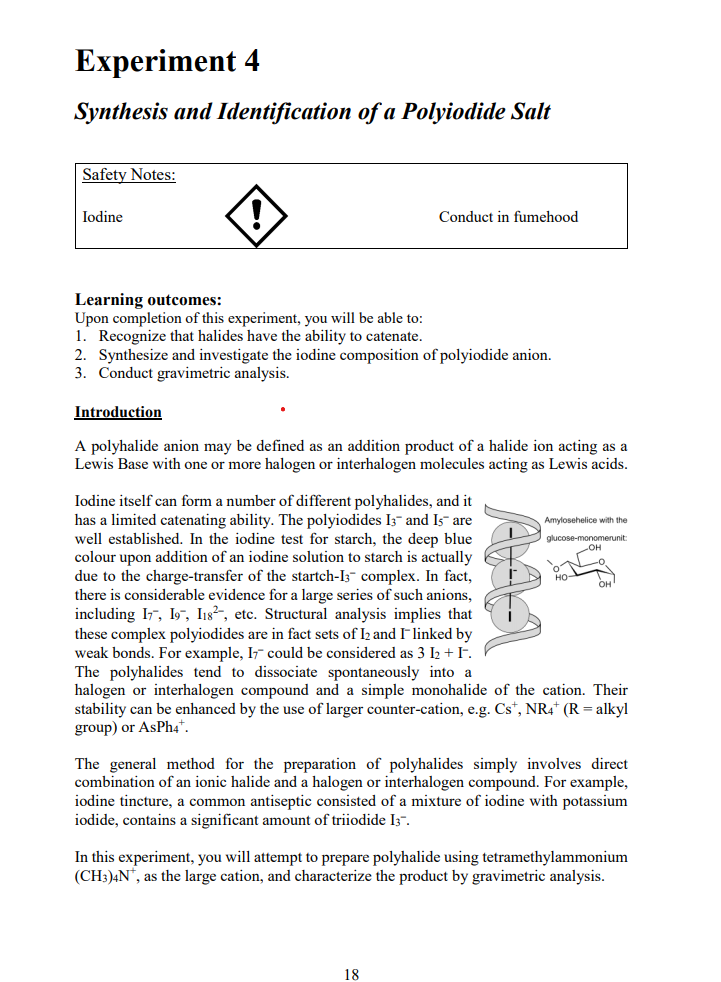In the synthesis of N(CH3)4Ix, what is the mole ratio of the two reactants used? Write a chemical equation for the reaction and state the expected value of x. Also calculate the yield of the synthesis
In the synthesis of N(CH3)4Ix, what is the mole ratio of the two reactants used? Write a chemical equation for the reaction and state the expected value of x. Also calculate the yield of the synthesis
Organic Chemistry
8th Edition
ISBN:9781305580350
Author:William H. Brown, Brent L. Iverson, Eric Anslyn, Christopher S. Foote
Publisher:William H. Brown, Brent L. Iverson, Eric Anslyn, Christopher S. Foote
Chapter21: Benzene And The Concept Of Aromaticity
Section: Chapter Questions
Problem 21.58P
Related questions
Question
In the synthesis of N(CH3)4Ix, what is the mole ratio of the two reactants used? Write a chemical equation for the reaction and state the expected value of x. Also calculate the yield of the synthesis

Transcribed Image Text:CHEM2341 Lab Manual
Part A. Synthesis of Polyiodide Salt N(CH3)4Ix
Weigh 0.5 g of tetramethylammonium iodide in a beaker and add 10 mL of ethanol.
Add 0.65 g of iodine and stir the mixture with moderate heating until no white solid
remains. Do not allow the solution to boil at any time. Allow the solution to cool slowly
to room temperature and finally in an ice bath for about 15 – 20 minutes. Collect the
product under with a Hirsch funnel and wash with 10 mL cold ethanol and 10 mL
diethyl ether. Dry the product in air. Record the weight, and calculate the percentage
yield.
Part B. Gravimetric Analysis
Weight accurately about 0.2 g of the product into a flask and add about 20 mL of ethanol.
1. Swirl the contents of the flask and add 50 mL of 0.05M silver nitrate solution in 10
mL portions.
2. Heat the mixture gently until all the precipitate has settled.
3. Filter the yellow product; wash with a little water followed by a little ethanol.
4. Weight the product, calculate the weight of iodine presents and hence the amount
of iodine in the original weight to the compound.
5. Calculate the percentage of iodine in your product and the value of x.
Reference:
Popov, Alexander I., Buckles, Robert E. Inorg. Synth. 1957, 5, 167.

Transcribed Image Text:Experiment 4
Synthesis and Identification of a Polyiodide Salt
Safety Notes:
Iodine
Conduct in fumehood
Learning outcomes:
Upon completion of this experiment, you will be able to:
1. Recognize that halides have the ability to catenate.
2. Synthesize and investigate the iodine composition of polyiodide anion.
3. Conduct gravimetric analysis.
Introduction
A polyhalide anion may be defined as an addition product of a halide ion acting as a
Lewis Base with one or more halogen or interhalogen molecules acting as Lewis acids.
Iodine itself can form a number of different polyhalides, and it
has a limited catenating ability. The polyiodides I3- and Is- are
well established. In the iodine test for starch, the deep blue
colour upon addition of an iodine solution to starch is actually
due to the charge-transfer of the startch-Iz- complex. In fact,
there is considerable evidence for a large series of such anions,
including I7, 197, I1s²-, etc. Structural analysis implies that
these complex polyiodides are in fact sets of I2 and I linked by
weak bonds. For example, I7 could be considered as 3 I2 +I.
The polyhalides tend to dissociate spontaneously into a
halogen or interhalogen compound and a simple monohalide of the cation. Their
stability can be enhanced by the use of larger counter-cation, e.g. Cs*, NR4* (R = alkyl
group) or AsPh4*.
Amylosehelice with the
glucose-monomerunit:
OH
но-
The general method for the preparation of polyhalides simply involves direct
combination of an ionic halide and a halogen or interhalogen compound. For example,
iodine tincture, a common antiseptic consisted of a mixture of iodine with potassium
iodide, contains a significant amount of triiodide I3".
In this experiment, you will attempt to prepare polyhalide using tetramethylammonium
(CH3)4N", as the large cation, and characterize the product by gravimetric analysis.
18
Expert Solution
This question has been solved!
Explore an expertly crafted, step-by-step solution for a thorough understanding of key concepts.
This is a popular solution!
Trending now
This is a popular solution!
Step by step
Solved in 2 steps

Knowledge Booster
Learn more about
Need a deep-dive on the concept behind this application? Look no further. Learn more about this topic, chemistry and related others by exploring similar questions and additional content below.Recommended textbooks for you

Organic Chemistry
Chemistry
ISBN:
9781305580350
Author:
William H. Brown, Brent L. Iverson, Eric Anslyn, Christopher S. Foote
Publisher:
Cengage Learning

Organic Chemistry: A Guided Inquiry
Chemistry
ISBN:
9780618974122
Author:
Andrei Straumanis
Publisher:
Cengage Learning


Organic Chemistry
Chemistry
ISBN:
9781305580350
Author:
William H. Brown, Brent L. Iverson, Eric Anslyn, Christopher S. Foote
Publisher:
Cengage Learning

Organic Chemistry: A Guided Inquiry
Chemistry
ISBN:
9780618974122
Author:
Andrei Straumanis
Publisher:
Cengage Learning
